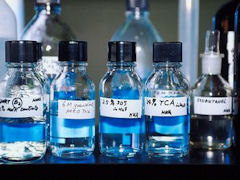Features
Valuable chemicals from bio-oils
Date: 2010-11-26 14:11:41.0
Author: Science
 The chemical industry might soon profit from a process which researchers at the University of Massachusetts-Amherst in the USA have optimized. According to their publication in the current issue of Science, they converted tar-like bio-oil into valuable hydrocarbons in a yield three times higher than before. These hydrocarbons included alcohols, aromatics and olefins which are normally derived from petroleum and are important feedstocks for the production of plastics, fabrics, pharmaceuticals and a lot of other everyday substances.
The chemical industry might soon profit from a process which researchers at the University of Massachusetts-Amherst in the USA have optimized. According to their publication in the current issue of Science, they converted tar-like bio-oil into valuable hydrocarbons in a yield three times higher than before. These hydrocarbons included alcohols, aromatics and olefins which are normally derived from petroleum and are important feedstocks for the production of plastics, fabrics, pharmaceuticals and a lot of other everyday substances.
Tushar Vispute and his colleagues have optimized the transformation process by adding two additional steps. Before running the liquid over a catalyst named zeolite, the scientists incorporated hydrogen into the raw material at two different temperatures using two different catalysts.
Bio-oil - also called pyrolysis oil - forms when lignocellulosic biomass-like wood and grass is heated up to several hundred degrees Celsius with subsequent cooling. It is a tar-like renewable liquid of low quality and the cheapest liquid fuel from biomass today. Bio-oil contains too much oxygen to be valuable as a fuel in its own right; but by raising the hydrogen content of the material, the scientists increased the hydrocarbon yield of the catalytic conversion process to 61 percent. Without supplying hydrogen, they achieved only 21 percent; the rest is wasted and forms coke, a solid carbon buildup, and gases like carbon dioxide.
Principal investigator George Huber at UMass Amherst explains "We are making the same molecules from biomass that are currently being produced from petroleum, with no infrastructure changes required." A pilot plant on the university campus is now producing these chemicals on a liter scale. The technology has been licensed to Anellotech Corp., co-founded by Huber.
Scientists at the Southeast University in Nanjing, China and at the University of Nottingham, UK were also involved in this study.
About the Department of Engineering, University of Massachusetts-Amherst
The University of Massachusetts Amherst is a public research and land-grant university in Amherst, Massachusetts and the flagship of the University of Massachusetts system. With more than 1,370 faculty members and more than 26,000 students, UMass Amherst is the largest public university in New England.
For abstract click: here
This article has not been tagged with keywords.
